

Sergey Karayev. CS491Y/691Y: Computer Vision Topics. Ehtml> CS491Y/691Y Computer Vision Topics Meets: MW 4:00pm - 5:15pm (SEM 234) Instructor: Dr.
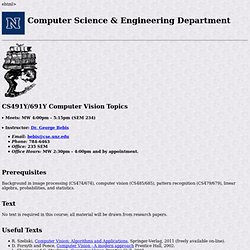
George Bebis Email: bebis@cse.unr.edu Phone: 784-6463 Office: 235 SEM Office Hours: MW 2:30pm - 4:00pm and by appointment. Prerequisites Background in image processing (CS474/674), computer vision (CS485/685), pattern recognition (CS479/679), linear algebra, probabilities, and statistics. Text No text is required in this course; all material will be drawn from research papers. Useful Texts R. Computer Vision resources Object Recognition Datasets Useful Software Description and Objectives Interest point detectors and descriptors are now at the core of many Computer Vision applications such as object recognition, 3D reconstruction, image retrieval and camera localization.
Syllabus Spring 2013 Schedule of Presentations W 1/23 Interest Point Detection (Bebis) Skanect by Manctl. Computer Vision Group - RGB-D Sensors (Kinect) RGB-D Sensors (Kinect) Contact: Jürgen Sturm In the past year, novel camera systems like the Microsoft Kinect or the Asus Xtion sensor that provide both color and dense depth images became readily available.
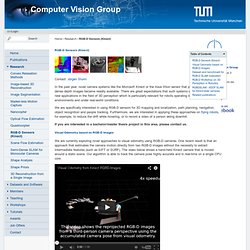
There are great expectations that such systems will lead to a boost of new applications in the field of 3D perception which is particularly relevant for robots operating in unstructured environments and under real-world conditions. We are specifically interested in using RGB-D sensors for 3D mapping and localization, path planning, navigation, object recognition and people tracking. Furthermore, we are interested in applying these approaches on flying robots, for example, to reduce the drift while hovering, or to record a video of a person skiing downhill. If you are interested in a bachelor/master thesis project in this area, please contact us. Rgbdslam. Electric: Cannot load information on name: rgbdslam, distro: electric, which means that it is not yet in our index.
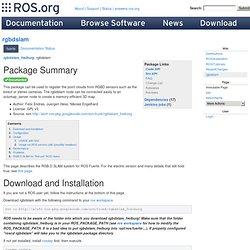
Please see this page for information on how to submit your repository to our index.fuerte: Documentation generated on December 26, 2012 at 03:53 PMgroovy: Cannot load information on name: rgbdslam, distro: groovy, which means that it is not yet in our index. Please see this page for information on how to submit your repository to our index.hydro: Cannot load information on name: rgbdslam, distro: hydro, which means that it is not yet in our index. Please see this page for information on how to submit your repository to our index.indigo: Cannot load information on name: rgbdslam, distro: indigo, which means that it is not yet in our index.
Please see this page for information on how to submit your repository to our index. Informatik.uni-freiburg. Fusion of Depth Maps with Multiple Scales - TU Darmstadt. This website provides material for the depth map fusion algorithm described in the following paper: Fusion of Depth Maps with Multiple Scales [Paper, 9MB] [YouTube Video] [MP4 Video, 64MB] Simon Fuhrmann and Michael Goesele In: ACM Transactions on Graphics (Proceedings of ACM SIGGRAPH Asia 2011), Hong Kong, China, 2011.
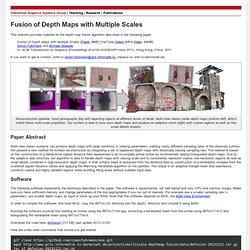
If you want to get in contact, write to simon.fuhrmann@gris.informatik.tu- (replace tu- with tu-darmstadt.de) Reconstruction pipeline. Input photographs (top left) depicting objects at different levels of detail. Multi-view stereo yields depth maps (bottom left), which inherit these multi-scale properties. Paper Abstract Multi-view stereo systems can produce depth maps with large variations in viewing parameters, yielding vastly different sampling rates of the observed surface. Software The following software implements the technique described in the paper.
Material Memex: Automatic Material Suggestions for 3D Objects. Arjun Jain Thorsten Thormählen Tobias Ritschel Hans-Peter Seidel MPI Informatik The material found on 3D objects and their parts in our everyday surroundings is highly correlated with the geometric shape of the parts and their relation to other parts of the same object.
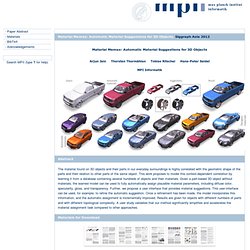
This work proposes to model this context-dependent correlation by learning it from a database containing several hundreds of objects and their materials. Given a part-based 3D object without materials, the learned model can be used to fully automatically assign plausible material parameters, including diffuse color, specularity, gloss, and transparency.
Further, we propose a user interface that provides material suggestions. Arjun Jain, Thorsten Thormählen, Tobias Ritschel, Hans-Peter Seidel Material Memex: Automatic Material Suggestions for 3D ObjectsACM Trans. This work has been partially funded by the Max Planck Center for Visual Computing and Communication (BMBF-FKZ01IMC01). We thank. Reconstructing the Surface of Inhomogeneous Transparent Scenes by Scatter-Trace Photography. BibTeX @MISC{Morris07reconstructingthe, author = {Nigel J.
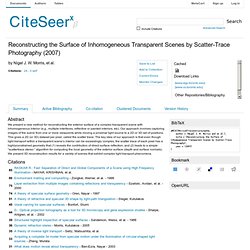
W. Morris and et al.}, title = {Reconstructing the Surface of Inhomogeneous Transparent Scenes by Scatter-Trace Photography}, year = {2007}} Bookmark OpenURL Abstract We present a new method for reconstructing the exterior surface of a complex transparent scene with inhomogeneous interior (e.g., multiple interfaces, reflective or painted interiors, etc). Citations. Refractive Height Fields from Single and Multiple Images. Zongker99.